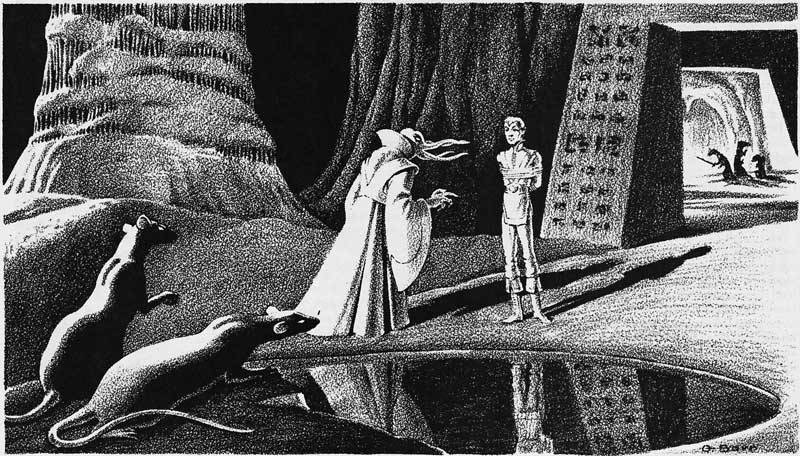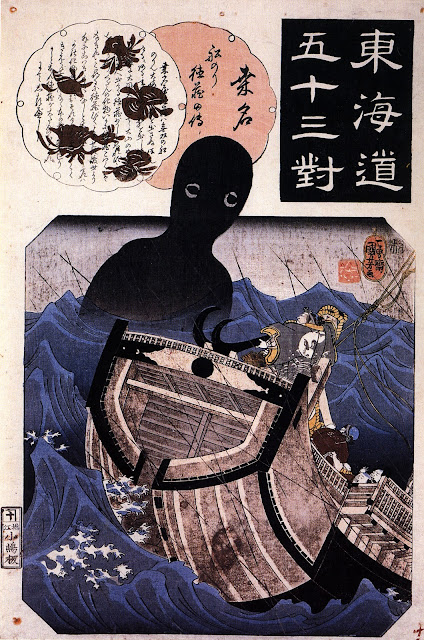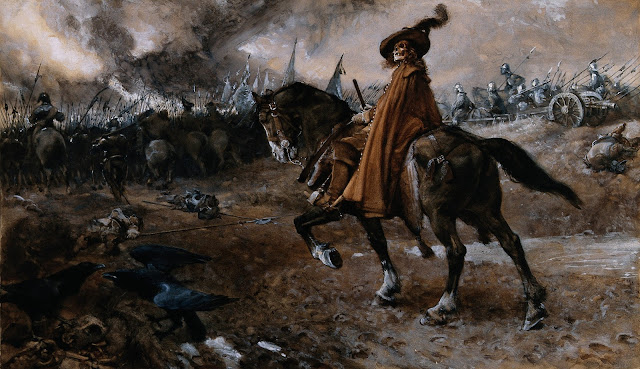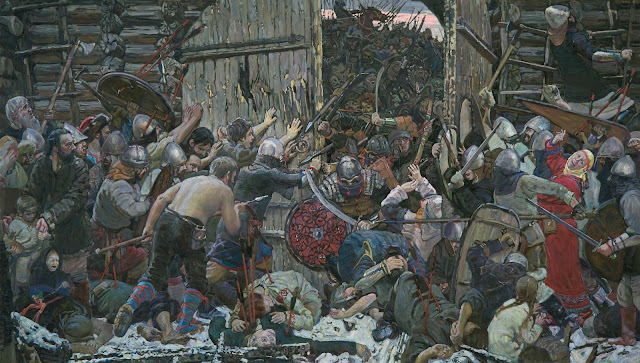The
emperor has commissioned an expedition to explore the icy north of the continent
– to reach the ruined, sorcerous realms of darkest Hyperborea. What exotic
provisions are provided? What hazards will they encounter? What happens when
the ice freezes the expedition in place?
This
post should provide a host of ideas to kickstart your own doomed arctic
campaign. The campaign is by definition - doomed, it’s a bleak and uncaring
experience. AMC’s The Terror is quintessential Appendix N viewing for this blogpost. While the series features the paranormal, transposing the doomed arctic expedition concept into a low-fantasy world, where magic is supposedly more common, only increases the potential for fantastically misery
inducing experiences and phenomena.
Below
you will find several tables that can used to generate your own unique polar voyage. Starting with the number and type of ships, the personalities of
the ship's officers, the supplies and crew (that sound good but will inevitably
backfire), the strange and deadly phenomena of the arctic circle and a list of
terrors that will doggedly hunt and destroy your wayward ships and ever
diminishing and decreasingly sane crew. Soundtrack 1 or Soundtrack 2.
The
Black Ruins of Hyperborea
A mysterious and ruined civilization known for it's black stone architecture. Great polished inky stones that sometimes defy gravity. While
this is the ultimate destination of the expedition, reaching the ruined cities
of Dread Hyperborea is not the point; failing on the way is. Should the
expedition reach that desolate place, they'd be met with even greater and insurmountable
struggles than they faced on the journey - demons awaking from millennial slumber, infinitely ancient
sorcerer-kings, floating labyrinthine complexes of ever changing cyclopean and
flawless stonework, the waking of countless cold-mummified Hyperborean thralls,
of swirling neon blackholes and eldritch UFOs.
Ships
of the Expedition:
The
expedition should be comprised of 1-3 ships, two is most recommended. The ships
are likely sturdy, albeit small, ex-military combat ships with complements of
50-75 men each.
If
you’d rather roll, your expedition is comprised of d3 ships. Roll for
each ship’s type using a d6.
1. Ex-Merchantman,
crew 50, well-travelled with ample storage – roll one additional specialist
item.
2. Old Gun-Brig, crew 70,
slow with one additional high-ranking officer.
3. Sloop-of-War, crew
100, still possesses a full battery of 20 cannons.
4. Bomb Ship, crew 60, sturdy
and hard to sink, still carries a bombardment gun and rockets.
5. Arctic Schooner, crew 20,
fast and designed to withstand the pressure of being trapped in the ice.
6. Fly-Ship, crew 40,
old fashioned but with an experienced crew.
(7.
Something more exotic like an airship, balloon,
strange beast, exotic ship or even a great many canoes)
Roll
an extra detail for each ship with a d8. The ship…
1.
is coated in crimson paint.
2.
has black sails.
3.
has a small shrine to minor god.
4.
the ship’s crew has a fantastic animal mascot.
5.
has a monstrous figurehead.
6.
is rumoured to be haunted.
7.
the ship’s mast is covered with priestly sigils and carvings.
8.
has a small scientific and alchemical laboratory with specimen jars of strange,
preserved creatures.
Roll for each
ship's name using a d4 and a d12 on the table below.
Leadership
Next, name and generate
the personality of each ship's captain and their second in commands. Then determine
the order of their seniority. Both these things will be very important should anyone die or become incapable of leadership. All
ships are assumed to have a medical officer/surgeon and a cook among many
other positions. Larger ships will have a complement of marines. These NPC’s
can be fleshed out as they come up in play.
Mundane
Resources and Provisions:
A
huge, detailed list of gear and provisions is not necessary to prepare. Assume
you have 3 years of rations for the expedition’s full complement and if
any player requests or searches for a specific item, decide by fiat if that item is or
is not available. If unsure, give a x-in-6 chance of that item being aboard.
Fantastic
Resources:
Each
ship also carries
3 specialist items or crew, roll for them randomly on this d20
table, decide on a case-by-case basis if you reroll the same resource or
crew member. These resources take the form of items, crew, additions to the
ship or missions the expedition must complete on its voyage. They are all damning
and despite best intentions will all actively make the journey more difficult
or drag it into complete ruin.
1. A repaired metal man,
a special gift from the emperor. An ancient war-relic of forgotten millennia,
now simply working as a tireless stevedore. Let us hope the black stonework of
Hyperborea not reawaken his memory of primordial, emotionless violence.
2. A lunatic veteran of
a failed expedition, he says he feels of sounder mind now and is surely safe
and stable. I've heard at night he sleeps in a lead lined coffin; heard he
screams in an unknown language too.
3. Half of our provisions
are preserved via a new alchemical method! These strange untested
chemicals will doubtlessly ensure our rations keep fresh and uncontaminated.
Whoever keeps whispering about side-effects and a 'mutation of the brain' are just
fear mongers.
4. We are accompanied by a cruel
witch, aboriginal to these regions. She will surely protect us from the
dread weather and malicious spirits that inhabit this polar region
5. The mummified body
of a dread Hyperborean. For reasons unknown to us, we are to return it
to the black, funerary halls of his eldritch empire. The men joke expectantly
about him coming back to life. They also say if he doesn't resurrect and the
ship runs low on good rations, they'll try eating him.
6. A local folk oracle,
one of those cunning-folk from back home whose visions will advise us and help
guide us through the ice. The crew are enamoured with him. He couldn't possibly
be a messianic sham who gives terrible advice.
7. A giant, mysterious egg
found on a previous expedition. Scientifically, we are meant to find whatever
laid it, but it could feed the crew for two weeks. Let us hope it doesn't
hatch, or we eat it and the mother find us!
8. A polished Hyperborean
stone, recovered from the captain's last expedition to Hyperborea. He uses
the floating stone as a mirror in his cabin. Surely it doesn't show him strange
dread-visions. The captain’s mind must remain sane for this expedition to be a
success!
9. The ship's fighting-marines
have been gifted dire-wolf fur coats by the Emperor himself. The wolves
were worshipped by some nameless cult of our empire's tribal enemies - their wolf-god's furs
are not inhabited by the beasts' ferociously vengeful, possessive and
animalistic spirits.
10. Astrovox. A modified
astrolabe that will supposedly be used to listen to the voices of the outer
planets. Their voices are said to better permeate our world in its most
northerly region. Let us hope their cosmic messages are kind, induce sanity and that their ire is not drawn against us.
11. Our ship is fitted with a Borealis
Attractor. Some hitherto untested and arcane machine that will call down
those alien lights so they we may better study and understand them. One would
suppose the lights are just that - light, but is the world not strange and
cruel? Great mysteries await.
12. Why are we loading so many
barrels of blood onto the ship? Is it a new, ghoulish alternative to lime
juice? I'd rather get scurvy if that's the case... and why do we never see the captain’s
second above deck during the day?
13. Our ship is fitted with an
experimental Solar Engine. The machine will melt the ice in the path of
our ships. It is surely a reliable, safe and stable machine and well worth the
6 months of food and supplies we had to leave behind so we could store the
Solar Engine's eminently corrosive fuel.
14. The crow’s nest (which is manned by a dark, unpopular and slightly
unhinged man) is fitted with an array of astronomical and nautical gauges along
with a sniper's rifle. It's a bespoke heavy-sharpshooter's rifle with
quick breech-loading and dense, armour-piercing bullets made of meteoric
iron. The gun can shoot at all angles, even down into the rigging and onto the
deck, though that would be very dangerous for the crew! Let us hope this malicious fellow remains of sound, loyal and patient mind.
15.
Ninety-nine great-turtles, stacked alive. They're very hearty, long-lived and make for
excellent long-term supply of meat. They're imported from a single, southerly
island and soon there won't be many left. I've heard tales also of some
parasitic-come-predatory leech from those parts that gestates within the
great-turtles. God-forbid it infect one of the men, it would mean a
blood-curdling end for him and hideous, killer creature for the rest of us.
16.
Diving Suits
for our mission to find evidence of a supposedly lost race of mythical,
arctic-ocean dwellers - the Deep Elves. We hope (should we encounter any) that their
nature is merciful, their intelligence comprehendible and benevolent (and their
architecture euclidean)
17.
The Resurrection
Pills. Though unpopular with the men, the chief surgeon has been ordered by
the naval academy to employ the use of Resurrection Pills. Why waste dead men
when we can bring them back? True, the resurrected aren’t good for thinking or
talking and after a while they start to act… peculiar but orders are orders. We
have brought many hundreds of these pills. Enough for each man aboard to be
brought back twice over.
18.
A crate
of featureless, whalebone masks. They were obtained from a polar culture
contacted 50 years prior to this expedition. The tribe had just begun a mask cult and these masks
were integral features of this tribe's newly burgeoning religion. Anthropologically, We are to check on them
to see how they have developed. Hopefully their faith has grown to promote hospitality and non-violence.
19.
A 'gift'
for the natives to keep them diplomatic, engaged and pliable. It’s an open
secret but in storage we have bushels and bushels of Yellow Zeng – the narcotic.
It’s always guarded but I’m sure the captain won’t mind us taking the odd pinch
of the stuff. It tastes like a good batch too, not that paranoia inducing cheap
stuff.
20.
The Captain's
pet indigo-tiger. God forbid we are unable to feed it.
What
terror doggedly pursues the crew?
This
is the main threat to the expedition that will hound it mercilessly. It is clever, has mastery over and immunity to the hostile landscape and is almost unkillable. There is only one threat of
this magnitude per expedition. Roll a d10
1.
The Bake-kujira, The Bone-Whale. A huge skeletal creature interested in
the souls of mortal men. It exudes debilitating protoplasm and chalk-board screams.
It is capable of swimming through the frigid wind in pursuit of men to devour.
2.
The Flesh-Golem. 12 foot to the shoulder, this charnel beast of a ‘man’
lives an exiled half-life of self-hatred in the polar north. His self-loathing
tempered only by his steely desire to visit abject vengeance upon mortal men.
It is highly intelligent, cultured and literate. Its fists can pulp a man’s
skull in a heartbeat.
3.
The Corpse-Mammoth. A wind-dried mammoth cadaver possessed by necromantic energies.
A purposeless, primeval lich-creature created by dark cosmic chance.
4.
The Monolith, high up against the white-grey sky a huge featureless black stone drifts across the horizon. It whispers in men’s minds, makes them do things to their compatriots.
Anyone that touches the stone has the blood drained from their bodies.
5.
The Star-Spawn. A writhing mass of tendrils and eyes that flies and swims
on membranous wings. It’s as old as time. It was there when the Hyperborean Empire fell.
6.
The Inupasugjuk. Twelve stories high, the Inupasugjuk is a cannibal
giant from beyond the northern ice sheet.
7. The
Savage King, a swirling ice mist of fang, tooth, fur, talon and tusk. The
Savage King of Wild Hyperborea embodies the primal destructiveness and
territoriality of its native fauna. It hates us and our civilised ways.
8.
The Polar God. At first, we thought it was just an idol. One of the aboriginal’s
carvings, only much larger. We were wrong – it’s alive.
9.
The Wendigo. We picked this fellow up off the ice. He was naked, very gaunt and
thin and wild but after warming him through and feeding him he spoke in our
accent. Says he’s the only survivor of his expedition but he’s not being
specific with the details. His eyes glint with preternatural malice. He ate his previous crew. He's a monster now.
10. The
Doomed Expedition.
Generate a new expedition with a single ship, a captain, special equipment/crew
and the things they encountered. Their undoings have become twisted strengths
in their forlorn undeath.
The
Weird Ways of the Polar North;
Weather
and other atmospheric/paranormal or environmental effects to be encountered
with a degree of regularity. Roll a d10 every 4 months after the
expedition’s first year.
1.
Arctic Pollen.
Strange neon spores cloud the polar winds drifting in streaks across the
grey-white sky and settling on deck, on your clothes, on your face. All we know
is that we should burn it out before it starts to grow.
2.
Carnivorous Ice.
Ice that eats. Nearly indistinguishable from any other ice flow save for the faint streaks of seal blood frozen into it. The flesh and bone-eating ice cracks under its
intended prey and quickly refreezes crunching and slicing away as a means of
attack and mastication. Carnivorous Ice is not alive as far as we can tell.
3.
Razor Lights.
Angled shafts of faint light, comparatively bright against the dim polar twilight, litter the seas and stony beaches of the polar north. Beware the lights as they
slash through cloth and flesh at the gentlest touch.
4.
Blizzard Watchers.
Sometimes during blizzards, we see them. Black specks that move through the
snow-grey clouds and hang above our ships. An officer observed them through his
looking glass and said they looked like men in flowing black robes and would
answer no other questions about what he saw.
5.
Screamers. The
first rescue party sent to investigate the cries never returned. We don’t know
what they are but after sunset and during the long sunless winter we hear them
screaming. These things scream out on the ice, usually they are far from the
ship and their shrill cries echo across the frozen waste. But recently, they’ve
been getting closer. The men are getting unnerved.
6.
Anti-Sun.
During the long night, when the sun sets and doesn’t rise again for months,
another alien sun takes its place. An inverted solar eye, of a deeper black set
against the darkness of the night, it emanates cold and malice. It wends
elliptically across the inky sky sometimes halting to glower above us.
7.
Creeping Snowdrifts.
Crawling across the ice fields or up your fur coat towards your face, the snow
is trying to asphyxiate you.
8.
Messenger Columns.
Huge pillars of solid, translucent ice thrice the height of a man stand
isolated against the flat, pebble strewn islands and cracked spines of the
ice-field’s bergs. Gazing into the column’s ink-swirled depths reveals
shimmering, hallucinatory images of distant lands, of your home. Nerve-shot
sailors find it hard or impossible to look away and will be found the following
morning frozen into the icy column.
9.
Flesh-Stripping Pseudo-Waves. Great, mindless, moving hills of sea-grey jelly,
rimed will polar frost that slowly circle the seas, icefields, tundra and rocky
islands of the Hyperborean north swelling and sweeping up unfortunate seals,
bears and sailors alike to be devoured in its colossal mass. These rare
phenomena emerge from the depths of the ocean to float across its surface or
press through cracks in the icefield sweeping the land for things to consume.
10. Poltergeist.
Whether an effect of the strange magnetism that confuses our compasses or
something altogether more supernatural, objects have been being stacked,
rearranged and thrown. All men must be wary should rigging be knotted, the
anchor dropped or an invisible hand carry a candle to the powder store.
Vignette
Encounters
These
things are typically only encountered once per expedition. Roll a d8 for
each year of the expedition, reroll results that have already been encountered
or use it as an opportunity to revisit them.
1.
Downed Monolith-Ship. We’d thought them only fanciful stories - of
men, sky-pirates taking to the biting wind atop Hyperborea’s floating black masonry. But here they are. Their crashed rock’s rope bindings and wooden platforms lie smashed on
the rocky shore. The crew’s skeletons scattering in the wind.
2.
Night Fliers. Tens of thousands of them, these flying things - like jellyfish filling the entire night sky.
3.
Northbound Souls. Pale bodies move just below the ice and float ever northward. I wouldn’t touch them; they make me feel sick.
4.
Isle of Skulls. Those aren’t stones…
5.
The Abandoned Ship. Roll a new ship, name and one fantastic
resource. The ship is completely abandoned, food and beds might still be warm. If the fantastic resource is a crew
member, they are the soul survivor and shouldn't be trusted.
6.
Friendly Aboriginals. Gods be praised. A tiny family of friendly natives.
They have too little food to spare to so many of us but they might teach us a thing
or two about how to survive.
7.
The Shaman, a funny fellow of the native sort – strange, esoteric rituals
and behaviours. If the shaman is mistreated by the crew a second terrible thing
from the terror table is unleashed on the expedition. If he is treated well the
shaman abates whatever is harrying the expedition for several weeks before
departing further north.
8.
Cannibal Shrine. The captain ordered us trusted crewmen to destroy it.
It was built from (and possibly by) our own kin folk and countrymen, we could
tell because the skeletons were wearing our nation’s uniform. It’s better the
widows back home keep thinking that their men just disappeared.



















.png)


























